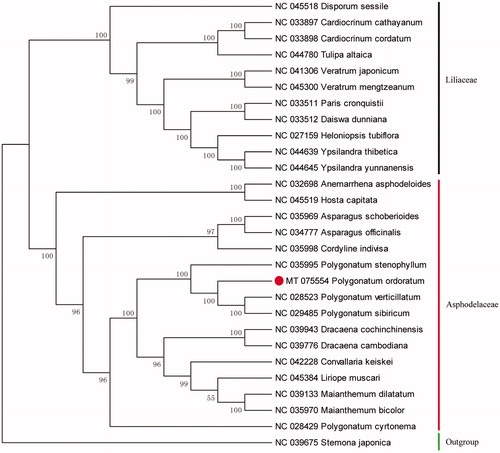Abstract
The first complete chloroplast (cp) genome of Polygonatum ordoratum has been reported in this study. The cp genome was 154,468 bp in length, containing a large single copy-region (LSC) of 83,417 bp, a small single copy-region (SSC) of 18,457 bp, and a pair of inverted repeat regions (IRs) of 26,297 bp, with an overall GC content of 37.76%. The cp genome contained 131 genes, including 85 protein-coding genes, 38 transfer RNA genes, and 8 ribosomal RNA genes. Phylogenetic analysis showed that P. odoratum was classified into a monophyletic group within the genus Polygonatum of Asphodelaceae.
Polygonatum odoratum (Mill.) Druce is native to Europe, Caucasus, Siberia, Russian Far East, China, Mongolia, Korea, and Japan (Zhou et al. Citation2015), and its rhizomes have been widely used in traditional Chinese medicine for removing dryness, promoting secretion of fluid, and quenching thirst (Zhang et al. Citation2014). The genus Polygonatum Miller includes about 60 species. Among them, 39 species are located in China, of which 20 are endemic to China (Chen et al. Citation2000). The taxonomy and phylogeny of the genus Polygonatum is controversial, which has been classified many times into Liliaceae (Chen et al. Citation2000), Ruscaceae (Chang Citation2002), and Asparagales (Meng et al. Citation2014; Jin et al. Citation2020). It is well known that the cp genome can provide effective information on studying the phylogenetic relationship of species (Nguyen et al. Citation2015). So far, the complete cp genome of five species of genus Polygonatum has been reported (Lee et al. Citation2019). However, the information on cp genome of P. odoratum is limited. To further determine the phylogenetic position of genus Polygonatum, the complete cp genome of P. odoratum was newly sequenced. Combined with the published taxa, we characterize the first complete chloroplast genome of P. odoratum and ascertain its phylogenetic position in this study.
Fresh leaves of P. ordoratum were collected from Cangshan mountain (25°41′4″N, 100°08′31″E) of Dali counties, Yunnan province, China. The voucher specimen was deposited in the herbarium of Dali University (HBGP0682). Total DNA was extracted using the DNeasy plant mini kit (QIAGEN, Hilden, Germany) and sequenced on an Illumina NovaSeq platform (San Diego, CA). Approximately, 4.19 Gb raw data (27,947,606 reads) was generated and used for de novo cp genome assembly with NOVOPlasty v3.7 (Dierckxsens et al. Citation2017), and all predicted genes were annotated using GeSeq (Michael et al. Citation2017). The annotated cp genome was deposited in the GenBank database under the accession number MN075554.
The cp genome of P. odoratum is 154,468 bp in length and exhibited a circular molecular structure, containing a large single copy-region (LSC) of 83,417 bp, a small single copy-region (SSC) of 18,457 bp, and a pair of inverted repeat regions (IRs) of 26,297 bp, with an overall GC content of 37.76%. A total of 131 genes were annotated, including 85 protein-coding genes, 38 transfer RNA genes, and 8 ribosomal RNA genes. The phylogenetic position of P. ordoratum was analyzed using the whole cp genome sequences of other reported 27 related species with Stemona japonica (NC039675) as an outgroup. The sequences were aligned using the MAFFT 7.409 (Katoh and Standley Citation2013). The maximum-likelihood (ML) analysis was conducted using RAxML v8.2.12 (Stamatakis Citation2014) with 1000 bootstraps replicates. The phylogenetic result strongly supported that P. ordoratum belongs to the genus Polygonatum of Asphodelaceae ().
Disclosure statement
No potential conflict of interest were reported by the author(s).
Additional information
Funding
References
- Chang G. 2002. A taxonomic review of Korean Polygonatum (Ruscaceae). J.Plant Tax. 4(32):417–447.
- Chen X, Tamura M, Duan B. 2000. Polygonatum Miller. In: Wu ZY and Raven PH, editors. Flora of China. 24th edn. Beijing: Science Press; p. 223–232.
- Dierckxsens N, Mardulyn P, Smits G. 2017. NOVOPlasty: de novo assembly of organelle genomes from whole genome data. Nucleic Acids Res. 45(4):e18.
- Jin J, Lao J, Zhong C, He W, Xie J, Hu GA, Liu H, Yan FL, Zhang SH. 2020. Complete chloroplast genome of a medicinal species Polygonatum kingianum in China (Asparagaceae, Asparagales). Mitochondrial DNA B. 1(5):959–960.
- Katoh K, Standley D. 2013. MAFFT multiple sequence alignment software version 7: improvements in performance and usability. Mol Biol Evol. 30(4):772–780.):
- Lee S, Zou Y, Liao W, Fan Q. 2019. The complete chloroplast genome of a traditional medicinal and food plant, Polygonatum humile (Asparagaceae, Asparagales). Mitochondrial DNA B. 4(2):3184–3185.):
- Meng Y, Nie Z, Deng T, Wen J, Yang Y. 2014. Phylogenetics and evolution of phyllotaxy in the Solomon’s seal genus Polygonatum (Asparagaceae: Polygonateae). Bot J Linn Soc. 176(4):435–451.
- Michael T, Pascal L, Tommaso P, Axel F, Ralph B, Stephan G. 2017. GeSeq-versatile and accurate annotation of organelle genomes. Nucleic Acids Res. 45(W1):W6–W11.
- Nguyen P, Kim J, Kim J. 2015. The complete chloroplast genome of colchicine plants (Colchicum autumnale L. and Gloriosa superba L.) and its application for identifying the genus. Planta. 242(1):223–237.
- Stamatakis A. 2014. RAxML version 8: a tool for phylogenetic analysis and post-analysis of large phylogenies. Bioinformatics. 30(9):1312–1313.
- Zhang H, Chen L, Kou J, Zhu D, Qi J, Yu B. 2014. Steroidal sapogenins and glycosides from the fibrous roots of Polygonatum odoratum with inhibitory effect on tissue factor (TF) procoagulant activity. Steroids. 89:1–10.
- Zhou X, Zhang Y, Zhao H, Liang J, Zhang Y, Shi S. 2015. Antioxidant homoisoflavonoids from Polygonatum odoratum. Food Chem. 1(186):63–68.

